| Competitive shooting has become extremely popular and there is a huge demand for guns that will meet the needs of the various classes. Springfield Armory has recently updated the 5.25 with .40S&W and .45ACP versions. These satisfy and exceed the specs for “major power factor” in USPSA and other governing bodies. Don’t miss the Springfield Armory 3 mag special through Nov. 30, 2012 at https://www.springfieldpromo.com/. Physically the guns are nearly exactly alike, and they come with all of the standard XD(M) features. Understanding the differences in the 9mm, .40S&W and .45ACP when it comes to competition boils down to the calculation of the “power factor,” which is the weight of the bullet times the velocity divided by 1,000. To “make major” you have to be at 160-170 in most disciplines. The Ransom Rest is a useful tool in evaluting the accuracy potential of a given handgun, but it is far from perfect and you still see flyers on the target. Most 5 shot groups came out to these results, where 3 or 4 of the shots are within an inch or so and one or two flyers expanded to group to just over 2 inches at 25 yards. This is the width measurement of the .45ACP. It measures 2.104 inchest, and the other guns measure 2.085 inches. This is a very small difference but you can feel it in your hand with the medium inserts. This is the other width measurement on the grip of the .45ACP version of the 5.25, which is also slightly thicker, 1.26 inches instead of 1.18 on the 9mm and .40S&W. I began my non-scientific experiments with Hodgdon Titegroup on my Hornady Lock and Load AP press trying to find the power floor. Hodgdon has a great resource on their website for finding load data for all of their powder lines, but not a lot on the power floor. I was able to work up a load for the power floor for .45ACP, coming out at exactly 125, but the gun stovepiped because the recoil is so light it can’t send the slide back far enough in the recoil cycle to properly eject the fired case. DO NOT TRY THIS AT HOME. At 3.7-4.0 grains of Titegroup, with the 230 Grain Hornady Action Pistol bullet, I was able to get an average 780 fps. This works out to a power factor of 179. |
Springfield Armory XD(M) Subsite
www.the-m-factor.com/
The last time we saw the new Springfield Armory XD(M) 5.25 I was only able to try the gun for about an hour before having to send it on to the next reviewer. GunsAmerica was the first to have pics and tests of this exciting new competition pistol designed by champion shooter Rob Leatham. At the time it was only available in 9mm as well. Several of the comments that came in asked the question, when are they going to offer it in .40S&W and .45ACP? The answer is “right now.” The guns should be on your dealer shelves, and there is still some time on the 3 magazines promotion from Springfield.
For competition, Springfield Armory has upped the game on the 5.25 with these two new guns. Both calibers give you more flexibility than the 9mm in competition. They give you the ability to make what is called “major power” in USPSA and other competitive shooting rule systems, and you can make doctored loads for what is called the “power floor.” With the .45ACP you can experiment quite a lot, as you’ll see we did some, and the .40S&W just makes the floor for major power factor, and may be your best option if you want to use the gun in competition as well as self defense or duty.
Power factors are all based on published rules for what the individual competition organizations. The speed of the bullets is measured by a chronograph at the competition itself. To calculate the power factor and figure out the power floor you multiply the weight of the bullet, in grains, with the measured speed in feet per second, divided by a thousand. So for a 125 grain 9mm travelling at 1100 feet per second it works out to 135. A 230 grain 45acp at 850 feet per second is 195.
You will notice that the power factor computation is far different than the foot/pounds computation we have covered in a number of other articles. In the latter, velocity is squared before it is multiplied. In power factor it is simply multiplied. So while in foot/pounds calculations velocity is king, in power factor bullet weight has much more impact.
To “make major” in USPSA for the Open division the power factor is 160, and it is 170 for the Standard and Modified divisions. The minimum caliber to “make major” in the Standard division is .40, which gives you two XD(M) 5.25 guns to choose from. Note also that there is an absolute power floor for USPSA and other competitions of 125. So if you are concerned only with competing at the division level without shooting to make major, you can load to the absolute floor for little or no recoil, if you can get the gun to work properly with low powered loads, as I will explain a bit later.
The XD(M) 5.25
What this new 5.25″ barreled version of the XD(M) brought into shooting sports was essentially an out of the box gun that is tuned for competitive edge. Rob Leatham is a Springfield Armory sponsored shooter, and is considered one of the best shooters of all time. His involvement brought instant validity to the design, and if you speak to him candidly, he will tell you that for a serious stock pistol shooter, this gun is a production gun dream come true.
All (M) versions of the XD have match barrels, but this gun has the longer competition match barrel, which gives you more velocity out of the same charge. A longer barrel means the powder has more time to burn before leaving the barrel. The 5.25 also has a larger sight radius and stock low profile adjustable sights that work really well. The top of the slide is ported for weight reduction, and the springs in the gun are made to work with a wide variety of bullet and velocity combinations.
Since it is easier to manipulate velocity while staying within the power factor in the .40S&W and .45ACP, the two new 5.25 guns were a welcome addition for many to the Springfield Armory line. This week Springfield also announced a new .45ACP version of the XD(M) Compact , and hopefully we’ll be looking at that gun in hand shortly. Details are at: https://www.the-m-factor.com/html/specs_11.html
Also, as I mentioned, we are coming to the end of the 3 magazines promotion by Springfield on these XD(M) guns. So if you have been thinking about buying one, now would be the time. The info on the promotion is at https://www.springfieldpromo.com/
Accuracy
The biggest complaint we got on the last article about the 5.25 was that there was no hard testing of the gun using a “Ransom Rest.” So when I decided to do a write up on these three guns that I had more time with I decided that I should order the grip inserts for the XD(M) from Ransom and get er done. Unfortunately the issue of the Ransom Rest isn’t as simple as people might think, and as we have been led to believe by a generation of gun writers in the print magazines.
The Ransom Rest is an invention that is meant to replicate the gun in a human hand throughout the firing and recoil cycle. You lock the grip of the gun in molded pads for that particular gun, and the device is meant to be a “machine rest,” to test the actual accuracy of the gun as a functional tool, with human factors completely removed. It kinda works, but not like you’d expect. For some guns my Ransom Rest results are much better than on sandbags, but on other guns the improvement is only marginal, and there are clearly flyers.
Unless you are a truly expert competitive shooter the Ransom Rest is only slightly better. With optics, even a 4x scope at 25 yards, I think the results would be much more drastic, but guns like the XD(M) don’t have a top rail. With iron sights, I am not a competitive shooter, and my ability to see the minute differences in a sight picture are not finely tuned. Also, the 6 5/8″ sight radius on this 5.25, is the longest you generally find in a pistol, but it is still extremely course compared to a rifle. Even my shorty M1A SOCOM has a 21 1/2″ sight radius.
That means that even a short rifle is almost 4 times finer than the longest pistol. The result is a nearly impossible guess at sight picture from one shot to the next. Technically, the Ransom Rest “locks” a gun into the same position, but I feel that unless you had lasers checking the actual position of the gun, similar to the way a CNC machine works, you can’t guarantee that Ransom Rest tests are the physical ability of the gun.
Semantics? Yes, to a large degree it is immaterial. How your hand is able to shoot the gun is all that matters. Often I have seen that though a gun is technically an accurate (or many would argue the correct word is precise”) tool, I shoot it poorly when it just simply doesn’t fit me, and that I will shoot a technically less accurate gun better when it does fit me. That is I feel the biggest factor with the XD(M) line of guns. Nearly everyone who shoots them will say that the guns fit them well, and this has led to a huge word of mouth following for the Springfield Armory XD(M) line in general.
The actual Ransom Rest test of this gun came out not much different than I can shoot with it on bags, just over 2″ at 25 yards. But the majority of the rounds consistently fell into about 1 1/4,” which is much better than I can shoot. I only tested the 9mm, mostly because of my frustration at seeing what were clearly flyers on the target that I knew were no fault of the gun and every bit the fault of the Ransom Rest and the shooter. I tried both re-aligning every shot and just returning the rest to battery, but the results were the same.
Comparing the 3 guns
Since these guns were built for competition I elected to only test them with Hornady Steel Match. The published velocity on the 9mm is 1146 feet per second. I measured the it in the 9mm 5.25 at an average of 1114. The .40S&W is published at 950 and the actual averaged 1010. And in the .45ACP the published is 850 and the average measured 788 out of my Pact Pro Chronograph. These work out power factors of 139.5, 181, and 181 respectively.
Making major power with the 9mm is from what I have seen impossible. But in the .40S&W, the minimum velocity for that 180 grain Hornady HAP (Hornady Action Pistol) bullet is is 944 fps. This is below the published velocity of Steel Match, and well within normal reloading tolerances for the caliber. The .45ACP cartridge is capable of easily making the 160 or 170 major power factor with most available loads, and you can experiment with the gun to find the load that works for you.
In the process of shooting these guns I decided to start testing loads that are engineered for the power floor in the 5.25, going for that target number of 125. So far I was only able to do .45ACP with one bullet, the Hornady 230 grain HAP and one powder, Hodgdon Titegroup. Finding a load for the power floor was easy. The charges fell between 2.7 and 3.1 grains in individual throws from the measure, and the velocity was right at the floor of 540 fps. average for a 230 grain bullet, to come up with 125 power factor. This load in the .45ACP has very little recoil, and not even enough to cycle the gun. You would have to buy a new spring from Springfield, or several of them, and test the gun by shortening it I suppose. People who load for the power floor are known as two names. Gamers, and winners.
WARNING: This is not reloading advice and you bear complete responsibility for your own handloads and your own shooting tests. This test was not done under scientific conditions and is not recommended at home. (Is anyone else embarrassed for what the lawyers have done to us?)
The grips on the 9mm and the .40S&W versions are the same. I measured at several angles and points with calipers and can’t find any difference. The .45ACP version is slightly, very slightly, larger, in both the thickness measurements. All of the XD(M) guns come with interchangeable backstraps for different sized hands. The magazine capacity is 19, 16 and 13 for 9mm, .40S&W, and .45ACP respectively. From what I could measure, the externals of all three guns are the same besides those things.
The .40S&W is an interesting caliber from a competition perspective. Since the 1911 is traditionally .45ACP, I think a lot of people migrate to that caliber as a default, but if you look at the numbers on the .40S&W, it looks to be much more competitive. There is less muzzle flip in factory loads that would qualify for the major power factor, and the grip size is the same as the 9mm, for those who want the extra capacity as well as a comfortable feel.
These 5.25 guns geared for competition, but it isn’t like they are under or over-qualified as a full sized duty pistol as well. The adjustable sights are extremely low profile and set down into the rear of the slide. I would consider them 85% snag proof, not a lot to watch out for. The front rail that is standard on the XD pistols is functional and can take lights and lasers like any duty pistol. And as we explained in the first article on this gun, Springfield gives you a whole bunch of gear, including a real paddle backed belt holster (though it doesn’t work with front mounted accessories). I think the added capacity of the .40S&W makes it very appealing as a duty gun, and it is suited for the major power floor in competition.
It isn’t a hard decision to buy any Springfield XD, especially the XD(M) line. They are elegant guns that always work, and far exceed the popular competitors in value. New models and configurations will be released throughout this coming year, filling most niches in the shooting, shooting sports, and duty/self defense market. This 5.25 series is now complete, and if you are looking for just a plain old great gun that will give you a competitive shot in USPSA or other pistol or 3 gun shooting discipline, the Springfield Armory 5.25 is a good bet.
We hope to follow up with all three of these guns in finding loads for the power floor and the major power floor. Surprisingly there isn’t a lot out there. So stay tuned for more appearances of these three Springfield XD(M) 5.25 guns. They are going to get a workout.
Springfield Armory XD(M) Subsite
www.the-m-factor.com/




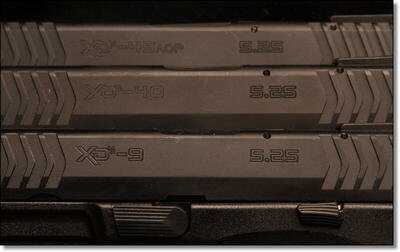
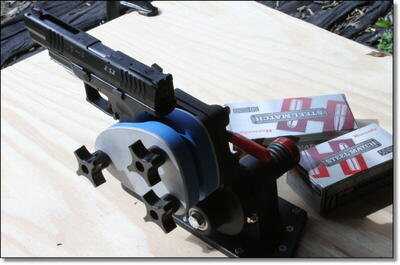

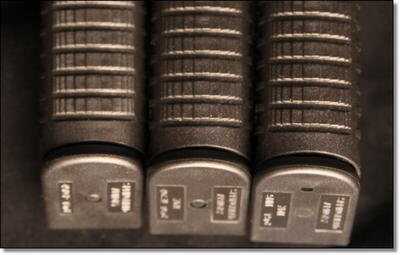


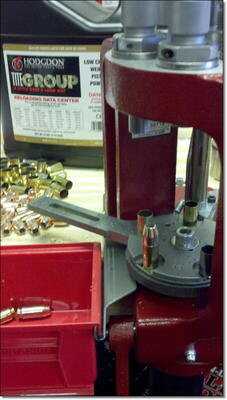
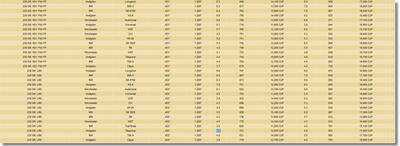

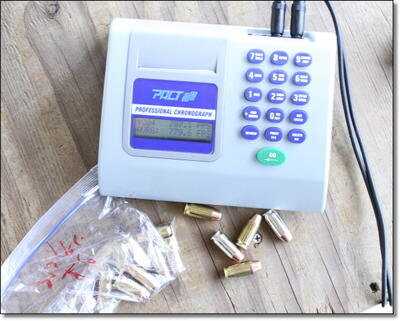

I thought it would be great for duty as well. Too bad I can’t find a basketweave level III duty holster for mine anywhere (per policy), so I can’t carry it.
I carry the 9mm version for duty and have found that the holster community hasn’t caught up to the 5.25″ competition models. However, the Blackhawk Omnivore works like a champ for either duty or civilian OWB carry. Check it out.
yes, Springfield Armory does offer an upgrade competition as well as tactical package on the XD as well as the XDS. You get a custom barrel, a acction job at tyour setting as well as a short reset trigger. It is worth the price of the competition package. The barrell is more accurate than the stock match and the lighter trigger pull and reset make in a more accurate pistol for shooters.
Apologize for being late to this discussion, but I’m looking to purchase a pistol and really like what I see of the XD(M) 5.25 .40S&W. My interest is not in completion, but more protection & frequenting gun ranges & practice. That being said, of the pistols I’ve fired I feel more comfortable with a longer barrel. I feel this gives slightly better accuracy. For this reason I’m drawn to the XD(M) 5.25 .40S&W, its large barrel, good power and slightly cheaper than the .45S&W (on ammo & pistol). However, since I’m not looking to do any competition, would I want to buy a completion style pistol? Thanks!
Sure, why not? What makes the XD(M) 5.25″ a great out-of-the-box competition weapon also makes it a great self defense weapon. You will find, however, that at the present time the aftermarket holster options are pretty meager. Until the holster community catches up, the plastic paddle holster provided with the gun is entirely adequate.
Thanks for the review of the XD/M 5.25! The after comments were almost as interesting. I am looking around for a good comp pistol in .40 or .45 and your review really helped. Thanks
The xdm 5.25 is fine and legal for IDPA in any caliber. Like said above, you would shoot the 9mm or .40 in ESP class instead of SSP, but that hardly matters at all. This gun seems to have been designed exactly for IDPA.
Can anyone tell me if the SA XDm 5.25″ is acceptable under IDPA rules?? The only reason I can see why it wouldn’t be is the “Competition Series” title that it is referred to as.
I own numerous SA handguns, including an XDm45 5.25 Comp, and an XD45c. The 5.25 has been flawless in function, for it’s first few hundred rounds. Accuracy is above what I expected from a poly gun (I generally collect/shoot 1911a1’s). I think SA has hit upon a winner in the new line. I think that I might have to check out that newly released XDm45SubCompact, pretty soon, tho my XD45c won’t be going anywhere.
More of a question than a comment; for a beginner in competitive pistol shooting is there any downside to a 9mm. I do not reload and am looking for being able to afford ammo to do a lot of practice? At least around here 9mm is fairly inexpensive when compared to 40SW and 45ACP.
It is really just that “major power” factor thing. A 9mm doesn’t qualify for really any major power classification with normal rounds, though some you can make with the subsonic 147grain. The .40 is fine if you reload and just buy starline brass, and a lee casting kit and make your own bullets with the lee luber. Lee makes a 6 bullet mold that works really well.
Ted,
The question of ‘major’ vs ‘minor’ in terms of power factor is possibly one of the more confusing aspects of competition shooting. As a beginner to the sport, go ahead and shoot 9mm and shoot in the Production class. Production has no “major” power factor – all calibers are treated as “minor” – and the rules are fairly strict about keeping your gun stock. You can make some internal modifications (and most people do) but it’s a very accessible class for beginners who are just bringing out what they’ve got. That’s for USPSA.
IDPA is a tiny bit different, but again, there’s a class that is very accessible to beginners: SSP (Standard Service Pistol). The power factor issue is even more moot in IDPA – .45s and all that are in their own class.
Ted, I wouldn’t worry so much about the power factor aspect. To the author of this review I say the same thing: it’s just not that important. The only people who worry about power factor are competitors shooting in Limited or Open and have compensated fully built-up race guns – the guys who have put a grand into modifying their pistol. Take one of these 5.25 XDMs to a USPSA match, as-is and out of the box, and shoot Production… there’s no reason in the world why you’d want anything but a 9mm, and it’ll probably do pretty darned well. Now, take that same gun and try to jump into the gear race of Limited or Open, and sure you’d want to start playing the power-factor game, experimenting with different calibers, etc. I don’t think it’s a fair assessment to the gun – especially as a review of the firearm – to factor in something as patently irrelevant to most shooters as competition ‘power factor’. Might as well start talking about the mythical ‘stopping power’, imho.
All this being said, YMMV. Be safe, and have fun!
For what it’s worth; When I shot ‘defensive pistol’ at my club this earlier this year, based on IDPA rules, they put Springfield XD’s and XDm’s in ESP class. Not SSP like Glocks.
What ever, it was still a lot of fun
Drover
the guy doesn’t know his ### from a hole in the ground when it comes to USPSA……or IPSC
I agree. He’s got his power factors mixed up – it’s convoluted..what a shame.
I wish the critics would offer some help. This information was taken from the wikipedia on this:
http://en.wikipedia.org/wiki/Power_factor_%28pistol%29
and the USPSA rule book, at
http://www.uspsa.org/rules/14th_Ed_US_html/14th_Ed_US_Rules.6.html.
The 160/170/125 numbers come from the divisions page in the rules at
http://www.uspsa.org/rules/14th_Ed_US_html/14th_Ed_US_Rules.11.html
So I’m not sure who is clueless here, but in light of the actual rules of the game, someone could let us know if there is something we have missed.
I own two. A first generation XD 45 ACP and another 40SW XDM. I am 77 years old and no longer compete in formal matches.
But, I do shoot the more informal ones that do not require physical strength and speed. I’ve done well (for my age and enjoy shooting my Springfields immensely.) Can I send in my XD 45acp for upgrades? I’m happy with the XDM40SW and would buy the XDM 5.25 in 9 mm.